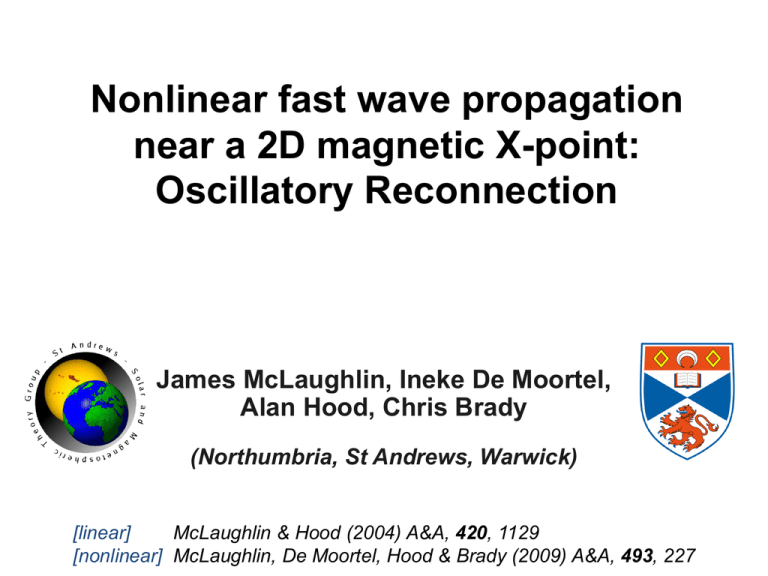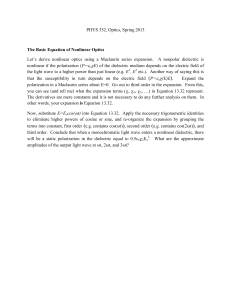Nonlinear fast wave propagation near a 2D magnetic X-point: Oscillatory Reconnection
advertisement

Nonlinear fast wave propagation near a 2D magnetic X-point: Oscillatory Reconnection James McLaughlin, Ineke De Moortel, Alan Hood, Chris Brady (Northumbria, St Andrews, Warwick) [linear] McLaughlin & Hood (2004) A&A, 420, 1129 [nonlinear] McLaughlin, De Moortel, Hood & Brady (2009) A&A, 493, 227 General Idea • Consider wave propagation near to equilibrium magnetic field – simple 2D X-point. B0 y, x,0 B0 L MHD Equations Solve with LARE2D code v v v p B B t B v B 2 B t v v t P 2 v v j t P where 1 53 B 0 A A zˆ Linear, Cold Fast Wave (Numerical + WKB) Extension to Nonlinear: Key questions • Now look at the properties and behaviour of nonlinear MHD waves in the neighbourhood of 2D null point. 1) Does the fast wave now steepen to form shocks and can these now propagate across or escape the null? 2) Can the refraction effect drag enough magnetic field into the null point to initiate X-point collapse or reconnection? 3) Has the rate of current density accumulation changed, and is the null still the preferential location of wave heating? Build up of jz Evolution of jz (0,0) jz (0,0) 0.862 time It is clear we have oscillatory behaviour, but do we have reconnection? Qualitative Evidence for Reconnection Quantitative Evidence Plot time evolution of Az (0,0) Changes in the vector potential at the origin indicate changes in connectivity. Quantitative Evidence Before t=2.6, no change After this, oscillates and displays clear downwards trend, Tends to straight line: A 105 8.615t 148.434 z This straight line is associated with the (final) current density remaining in the system: A 1 2 1 z t Rm Az Hence, if our final state contains constant current density, then we expect Az to change linearly in time. Integrating and comparing to the Straight line gives final current density of 0.8615, in agreement with current. Rm jz Quantitative Evidence Remove straight line trend: 105 Az (0,0) A1 8.615t 148.434 Can clearly see oscillatory nature of system Conclusions Investigated behaviour of nonlinear MHD fast waves in the neighbourhood of 2D null point. 1) Does the fast wave now steepen to form shocks and can these now propagate across or escape the null? Yes, nonlinear behaviour is completely different to linear case. Fast and slow shocks form and cross null. Shocks intersect & (asymmetrically) heat plasma via jets (β≠0). 2) Can the refraction effect drag enough magnetic field into the null point to initiate X-point collapse? Nonlinear wave deforms X-point. Oscillatory reconnection: * Cycle of horizontal and vertical current sheets. * Changes in vector potential at origin indicate changes in connectivity. Final state in force-balance, but non-potential. 3) Has the rate of current density accumulation changed, and is the null still the preferential location of wave heating? Current density now forms in many locations: current sheets, shock fronts. Neutral point no longer preferential location for heating. – [linear] McLaughlin & Hood (2004) A&A, 420, 1129-1140 – [nonlinear] McLaughlin, De Moortel, Hood & Brady (2009) A&A, 493, 227-240






